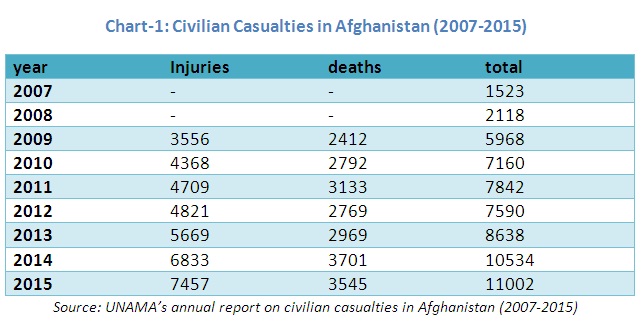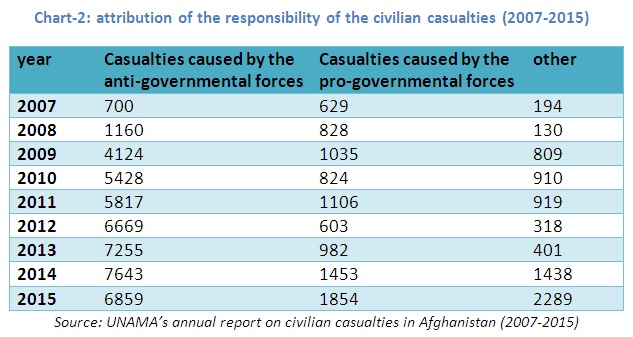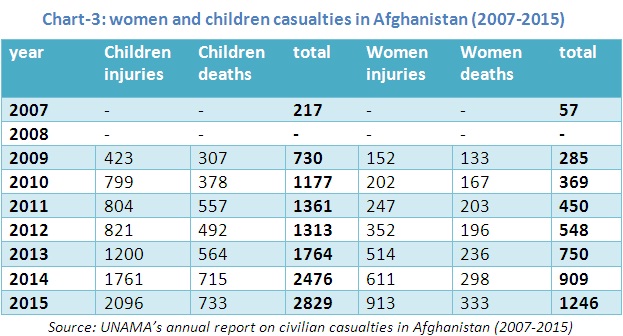The factors and outcomes behind record high civilian casualties
United Nations Assistance Mission for Afghanistan (UNAMA) released its ninth annual report about the civilian casualties in Afghanistan on 14 February 2016, which stirred reactions across Afghanistan. After the collapse of the Taliban in Afghanistan, 2015 was the bloodiest year for civilians. According to the report, UNAMA documented 11002 casualties in 2015. It was also a bloody year for women and children compared to the past nine years, where 2829 children casualties and 1246 women casualties were calculated this year.
Civilian casualties in the past years, attribution of the responsibility of civilian casualties, ISIS’s role in the civilian casualties and the reasons behind increase in civilian casualties are the issues that will be discuss here.
The background of civilian casualties in Afghanistan
Following the communist coup d’état and the Soviet invasion of Afghanistan civilian casualties increased in the country. The Soviet War in Afghanistan left 0.85 to 1.5 million of civilians’ deaths and around 3 million wounded.
However there are no reliable statistics about civilian casualties during Afghan Civil War, but according to United Nations (UN) calculations only between May and August of the 1992, around 1800 civilian were killed in Kabul city from rockets and mortars; based on another estimation of the UN in 1994 around 25 thousands of people were killed only in Kabul and most of them were civilians.
Civilian casualties (2001-2015)
In 2001, when the US and Coalition forces attacked Afghanistan the number of civilian casualties increased and had reached around 2375 casualties. Later from 2002 to 2006 a total of 2422 civilians were killed. It should be noted that this statistic was not put together by any official administration or organ and is only a result of individual efforts by researchers.
UNAMA began documenting civilian casualties in 2007 but its annual reports in 2007 and 2008 are different than its reports in 2009 and the years after that from a methodological point of view.
If one study UNAMA’s annual report on civilian casualties in Afghanistan, the statistics of the civilian casualties provided by this institution would lead one to conclude that whenever insecurity has increased or the war has intensified between the Taliban on one side and the Afghan Government and foreign force on the other side, the civilian casualties has also increased. After 2007, every year (except 2012) the civilian casualties have increased (see the Chart-1 for further information). In 2007 there were 1523 civilian casualties while in 2015 this number increased to 11002.
Since 2009, the number of civilian casualties has increased annually but the number of civilian deaths decreased in 2012 and 2015 (see the Chart-1 for further info).
It should be noted that in this statistics UNAMA has not included those incidents of civilian casualties which were not verified or were out of the reach of UNAMA; and neither the casualties caused by drone attacks and the foreign forces are included in these statistics.
Attribution of responsibility for civilian casualties
The annual report of UNAMA demonstrates that in 2015 the civilian casualties have unprecedentedly increased. In this year, 3545 civilians are death and 7457 civilians are injured. UNAMA attributes 62% of the civilian casualties to Anti-Government Elements and 17% to Pro-Government forces. The report further says that from 2007 to 2014 more civilian are harmed annually in the attacks of the government’s armed oppositions. 700 civilians in 2007 and 7643 civilians in 2014 were the victims of the attacks carried out by the armed oppositions. But according to the UNAMA’s annual report in 2015 the numbers of the civilian casualties by the armed oppositions has decreased and has declined to 6859 civilians.
According to UNAMA the term “Anti-Government Elements” encompass all individuals and groups involved in war against the Government of Afghanistan including the Taliban, Hezb-e-Islami, Islamic Movement of Uzbekistan, Islamic Jihad Union, Lashkari Tayyiba, Jaysh Mohammad, ISIS and other armed oppositions.
On the other hand the number of civilians attributed to the Pro-Government forces show decrease and increase in different times. This number has decreased in 2010 and 2012 but has begun to increase after 2012. In 2015 the civilian casualties caused by the Pro-Government forces has reached maximum levels compared to the past years, in this year the Pro-Government forces were responsible for 1854 civilian casualties (see the Chart-2 for further info).
The casualties of women and children (2007-2014)
Along with the deterioration of the security situation in the country the number of civilian casualties has also increased; meanwhile the number of women and children casualties have also increased annually which is the ugliest aspect of the current war in the country.
According to the Statistics of UNAMA in 2007, 217 children and 57 women were either killed or injured while these numbers increased to 2829 children and 1246 women in 2015. Thus both deaths and injuries of children and women are increasing every year. (See the Chart-3 for more info)
The Reasons behind increased civilian casualties
- War: whenever the war has intensified in various regions of the country; civilian casualties have also increased.
- Explosions: another important factor that increased civilian casualties last year was the bloody explosions in Kabul and other cities of the country. For example in the explosion of Shah Shaheed in Kabul dozens of civilians were killed and dozens others were injured to which no entity has claimed responsibility.
- ISIS: the head of UNAMA’s Human Rights unit in a press conference said: “according to the findings of UNAMA ISIS is responsible for 83 incident of civilian casualties 82 of which had occurred in Kaut, Achin, and Spinghar areas of the Nangerhar province and as a result, 39 civilians were killed, 43 injured and 82 were abducted.
- Military operation of the government: the annual report of UNAMA shows that Pro- Government forces are responsible for 17% of the civilian casualties in the country. The reason behind this is aggressive offensives carried out by the Afghan security forces.
- The fall of Kunduz and recent events in Baghlan: with the expansion of war in the Northern provinces particularly during the collapse of Kunduz many civilians were killed and many others were wounded, but no exact survey was conducted to collect specific statistics. On the other hand, UNAMA has documented around 20 incidents in Baghlan province most of which have occurred in Paul-e-khumri, Dushi and New Baghlan. This administration also confirms 27 civilian casualties while 7 civilians were killed and 20 civilians were injured including two women and 13 children.
The Taliban and the Afghan government’s response
The Taliban and the Afghan Government has responded to the recent report of UNAMA on civilian casualties. The Presidential Office and Afghan Chief Executive Office rejected some parts of the report. UNAMA has declared in part of its report that civilian casualties caused by the ground operations of the Taliban has decreased. Releasing a newsletter the Presidential Office has said that they are not agreed to the 42% decrease in the ground operations of the Taliban.
Presidential Office has also questioned the report due to the non distribution of 13% of the civilian casualties to a specific group. This newsletter has also added that the Taliban has always violated international laws and thus the presidential Office has criticized that part of the report that has declared that civilian casualties by Anti-government Elements have decreased.
Some civil society activists have also declared the report as unilateral and against Afghan security forces. But United Nations special representative of the Secretary General in Afghanistan, Nicholas Haysom while releasing the report had said that they have used developed systems in order to collect these figures and that they have shared the report with engaged parties before it was released.
On the other hand the Taliban has also declared that the report was unilateral. In a statement Zabi-ullah Mujahed the Taliban’s spokesman said: “the report is unilateral, promotional and in favor of the occupying forces”.




